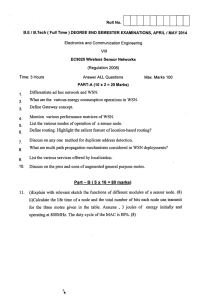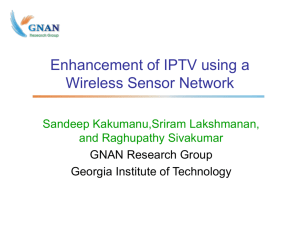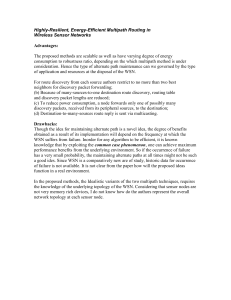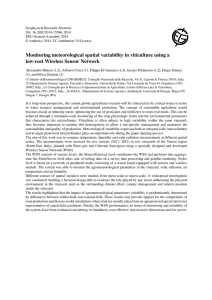A Novel Approach for Ultra Low-Power WSN Node - HAL
advertisement
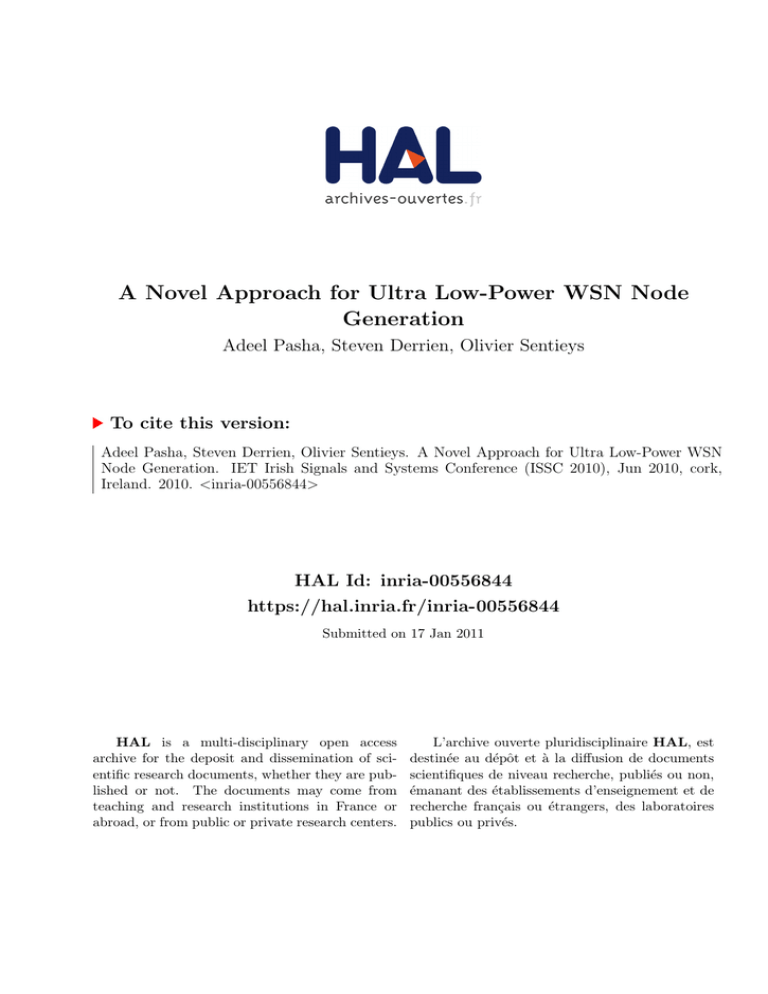
A Novel Approach for Ultra Low-Power WSN Node Generation Adeel Pasha, Steven Derrien, Olivier Sentieys To cite this version: Adeel Pasha, Steven Derrien, Olivier Sentieys. A Novel Approach for Ultra Low-Power WSN Node Generation. IET Irish Signals and Systems Conference (ISSC 2010), Jun 2010, cork, Ireland. 2010. <inria-00556844> HAL Id: inria-00556844 https://hal.inria.fr/inria-00556844 Submitted on 17 Jan 2011 HAL is a multi-disciplinary open access archive for the deposit and dissemination of scientific research documents, whether they are published or not. The documents may come from teaching and research institutions in France or abroad, or from public or private research centers. L’archive ouverte pluridisciplinaire HAL, est destinée au dépôt et à la diffusion de documents scientifiques de niveau recherche, publiés ou non, émanant des établissements d’enseignement et de recherche français ou étrangers, des laboratoires publics ou privés. ISSC 2010, UCC, Cork, June 23–24 A Novel Approach for Ultra Low-Power WSN Node Generation Muhammad Adeel Pasha, Steven Derrien and Olivier Sentieys University of Rennes1, IRISA/INRIA Campus de Beaulieu, Rennes FRANCE E-mail: adeel.pasha@irisa.fr steven.derrien@irisa.fr olivier.sentieys@irisa.fr Abstract — Wireless Sensor Network (WSN) technology is now emerging with applications in various domains of human life e.g. medicine, environmental monitoring and military surveillance etc. WSN systems consist of low-cost and low-power sensor nodes that communicate efficiently over short distances. It has been shown that power consumption is the biggest design constraint for such systems. Currently, WSN nodes are being designed using low-power microcontrollers. However, their power dissipation is still orders of magnitude too high and limits the wide-spreading of WSN technology. In this paper, we propose an alternative approach that uses hardware specialization and power-gating to generate distributed hardware micro-tasks. We target control-oriented tasks running on WSN nodes and present, as a case study, a lamp-switching application. Our approach is validated experimentally and shows prominent power gains over software implementation on a low-power microcontroller such as the MSP430. Keywords — Hardware Specialization, Low-Power Micro-Architecture, WSN I Introduction Recent advancements in micro-electro-mechanicalsystems (MEMS) technology, wireless communication, and digital electronics have facilitated the development of low-cost, low-power, multi-functional sensor nodes that are small in size and communicate efficiently over short distances. Systems of 1000s or even 10,000s of such nodes are anticipated and can revolutionize the way we live and work. A Wireless Sensor Network (WSN) is composed of a large number of sensor nodes, that are densely deployed either inside a region of interest or very close to it. Each node consists of processing capability (one or more microcontrollers with associated memory (RAM/Flash)), communication capability (an RF transceiver) and can accommodate various sensors and actuators. Power consumption has been realized as the biggest constraint in the design of a WSN node. Since the nodes must be low-cost and small in size [1], it is not possible to equip them with a huge source of energy. To make the situation worse, WSN nodes may have to work unattended for long durations due to difficult access to them or a huge number of nodes. As a result, they must survive with self-harvested (e.g. solar cells) or non-replenishing (e.g. batteries) sources of energy. All these restrictions toward energy retrieval make power consumption the most important design parameter. In recent years, WSN nodes have been designed using low-power microcontrollers such as the MSP430 [2] from Texas Instrument or ATMega128L [3] from Atmel Corporation. These programmable processors share common characteristics such as a reasonable processing power with low power consumption at a very low cost. However, power dissipation of these devices is still orders of magnitude too high for application domains such as WSN, since these systems expect sensor nodes to operate with extremely limited energy resources for very long time periods (months if not years). Moreover, because these nodes remain idle during most of their lifetime, their static power consumption plays a major role in their actual energy budget. In such situations, the only way to further improve the energy efficiency of such a system is to customize its design to the application at hand. The approach consists in implementing each task of a control-oriented application graph on a powergated specialized hardware architecture (called hardware micro-task ). This architecture is in the form of a minimalistic datapath controlled by a custom Finite State Machine (FSM) and is being automatically generated from a task specification in C, using an ASIP-like retargeted design environment. The approach results in improving both the dynamic (thanks to hardware specialization) and static (thanks to power-gating) power of the WSN node. In this paper, we are investigating the application of this hardware specialization approach from WSN perspective. We propose, as a case study, a lamp-switching application in which a transmitting node demands a receiving node to switch on/off its lamp if a button is pressed at transmitter end. The main contribution of this article lies in investigating the power benefits of power-gated hardware micro-tasks based approach. A simple yet realistic case study of a WSN example also serves as an experimental validation that the approach is conceivable for real-life WSN applications. We also provide the SPICE transistor-level timing simulation results to show that the on/off-switching delays of the power-gated micro-tasks are within the acceptable range and even better than that of traditional low-power microcontrollers such as the MSP430. Our experiments show that dynamic power savings of one to two orders of magnitude can be obtained for different control-oriented tasks of our application (w.r.t. a low-power MCU such as the MSP430). Moreover, since the tasks are powergated, their static power consumption will be virtually zero when the WSN nodes will be in sleep mode. The rest of this paper is organized as follows. We start by presenting the related work in Section II and describe thoroughly our proposed case study in Section III. In Section IV, we present experimental results which confirm the validity of the approach. Finally, conclusion and future research directions are drawn in Section V. II Related Work In the last decade, a wide range of applications for sensor network have been developed. Some of the application areas are environment, military, health, and security. WSN may consist of many different types of sensors such as seismic, low sampling rate magnetic, thermal, visual, infrared, acoustic and radar. These sensors are able to monitor a wide variety of ambient conditions such as temperature, humidity, lightning, pressure, and vehicular movements etc [4]. This section details the literature study of some of such WSN applications. Later in the section, we highlight some application benchmarks that have been proposed for WSN. Finally, we present some power optimization efforts done at micro-architectural and operating system level in the context of WSN. a) Important WSN applications Environmental monitoring is an important application of WSN. In reference [5], a habitat monitoring system is discussed. Similarly, forest fire detection and prevention [6], and detection of volcanic eruptions [7] are other examples of environmentmonitoring WSN systems. WSN can also be used as an integral part of military command, control, communication, computing, intelligence, surveillance, reconnaissance and targeting (C4ISRT ) systems [8]. The rapid deployment, self-organization and fault tolerance are some characteristics that make WSN a very promising sensing technique for military C4ISRT systems. Moreover, the benefits of WSN have also been proved in other domains of human life such as health monitoring and home applications [9, 10]. b) WSN application benchmarks We have seen in this section that WSN applications consist of a heterogeneous nature as they are pretty different in their overall goals to be achieved. However, the basic tasks performed in a WSN node are quite similar. These tasks are: sensing a certain phenomenon, gathering its relevant data and forwarding it to a base-station in a pre/post-processed state. Several attempts have been conceived to profile the workload of a generic WSN node. Two of the recent application benchmarks for WSN are SenseBench [11] and WiSeNBench [12]. Both of them have tried very well to cover the general applications and algorithms that can be run on a typical WSN node. c) Low-power MCUs and operating systems As far as power optimization of WSN domain is concerned, many research efforts have been made. These works cover all the design aspects of a WSN from application layer of the communication stack to the physical layer (e.g. efficient routing algorithms, low-power medium access control (MAC) protocols etc.). However, since the focus of our research work is the micro-architectural level, we try to summarize the characteristics of low-power micro-controllers (such as the MSP430 and the ATMega128L) that have been developed for lowpower applications and the light-weight operating systems running on them. The common characteristics of such MCUs are: a simple datapath (8/16-bit wide), a reduced number of instructions (only 27 instructions for the MSP430), and several power saving modes that allow the system to select the best compromise between power saving and reactivity (i.e. wakeup time). These processors are designed for lowpower operation across a range of embedded system application settings but are not necessarily well-suited to the event-driven behavior of WSN nodes as they are based on a general purpose, monolithic compute engine. For example, Mica2 mote [13] has been widely used by the research community. It is a complete WSN node based on a ATmega128L MCU, with I/O peripherals, an RF transceiver and sensor devices. Measurements of Mica2 show that its MCU consumes an average 8 mA of current when active and approximately 15 µA when in low-power mode. The MSP430F1611 used by Hydrowatch platform consumes a nominal 500 µA [14] whereas the latest version of MSP430 (MSP430F21x2) consumes approximately 8.8 mW (@ 16 MHz). It is an acknowledged fact that the power budget of a WSN node that would rely only on energy harvesting technologies is estimated to be around 100 µW [15]. Comparing this constraint with that of current MCUs power consumption profiles clearly drives us toward alternative architectural solutions (e.g. hardware specialization of the system). Moreover, most of currently used MCU packages include a limited amount of RAM (only a few hundred Bytes to a few kilo-Bytes). This limited amount of storage resources poses great challenges to the software designers since both the user application and operating system must work with this very small amount of memory. As a consequence, there have been several attempts to reduce the complexity of the operating system (OS) on these devices. In particular, many approaches have been proposed to reduce the overhead caused by dynamic scheduling of the threads by using alternative concurrency computational models. For example, TinyOS [16] is built upon an event-driven approach, without explicit thread management, and Contiki [17] proposes a simplified thread execution model (named protothread ), in which preemption can only occur at specific points in the task control flow. III Proposed approach The section starts by explaining the case study used in the current work and later on, outlines the notion of micro-task and the generic architecture of a WSN node built using the proposed approach. a) Proposed case study WSN applications, being event-driven in nature, can be represented as Tasks Flow Graphs (TFGs) where a task execution is triggered by events, be they external or produced by another task. This section highlights the important control tasks of our lamp-switching WSN application during transmit as well as receive mode. The controlflow of the proposed node is based on RICER (Receiver Initiated CyclEd Receiver) MAC protocol [18]. Briefly speaking, data transmission by a transmitter node is initiated upon reception of a wake-up beacon from the desired receiver node. Fig. 1 (a and b) shows the TFGs of the proposed node in transmit and receive mode, respectively. a).1 Control tasks running on a WSN node in transmit mode Here are the basic control tasks running on a our WSN node in transmit mode: • Wait for wake-up beacon: Upon reception of an external event (buttonPushed ) or an ackNOK event, the transmitter node waits for the wake-up beacon from the desired receiver node according to RICER protocol. We have written a C-function, called waitForBeacon(), that actually starts a timer and reads the data packets received by its RF transceiver through Serial Peripheral Interface (SPI) bus. In our example, we are using CC2420 radio chip from Texas Instrument [19] as RF transceiver. If the transmitter receives the required wake-up beacon before the timer expiry, it generates a beaconReceived event. Otherwise, a timeOut2 event is generated by the task. • Sending data: The next task is data transmission that is described in sendData() function. This function writes data frame to the physical interface of the radio transceiver through SPI bus and generates a dataSent event. • Receiving acknowledgment: After sending data, the transmitter node waits for an acknowledgment frame from the receiver using receiveAck() function. If it receives the acknowledgment correctly, it generates an ackOK event, otherwise an ackNOK event is generated. • Shutting down the transceiver: Upon reception of ackOK or timeOut2 event, the transmitter node will shut down its RF transceiver to save energy. This is done through shutDownRadio() function, that sends appropriate signals to RF transceiver to shut it down. a).2 Control tasks running on a WSN node in receive mode The control tasks running on a WSN receiver node of our case study are as follows: • Sending a wake-up beacon: Our proposed WSN node periodically broadcasts a wake-up beacon to announce the neighbors to initialize a communication. This control task waits for an external event timerEvent for its activation. This external event is periodically generated by a hardware timer. The corresponding C-function for the task is described in sendBeacon() function that generates a beaconSent event. • Receiving and analyzing data: After sending the beacon, the receiver waits for the data timerEvent sendBeacon() MT1 r_Idx,r_Idy beaconFrame beaconSent buttonPushed receiveData() counter_Val r_Idx,r_Idy waitForBeacon() MT1 MT2 dataReceived beaconReceived r_Idx,r_Idy t_Idx,t_Idy dataFrame sendData() MT2 ackNOK t_Idx,t_Idy dataFrame sendAck() MT3 t_Idx,t_Idy ackFrame ackSent dataSent timeOut1 timeOut2 switchLamp() MT4 LED port receiveAck() MT3 ackOK lampSwitched shutDownRadio() MT4 MT5 shutDownRadio() (b) receive mode (a) transmit mode Fig. 1: System-level task flow graphs of a WSN node in transmit and receive modes frame from any transmitter. The task is described in receiveData() function that starts a timer for possible time-out and receives and analyzes the data frame if it is destined for the receiver node or not. In case of valid data, it generates dataReceived event whereas if the timer is expired and no valid data is received, a timeOut1 event is generated. • Sending acknowledgment: Upon successful data reception, the receiver generates an acknowledgment for the transmitter node by calling sendAck() function that sends an acknowledgment frame to its RF transceiver and generates a ackSent event. • Switching the lamp: The next task, in receiver TFG, is switching the lamp that is accomplished by calling the switchLamp() function. This function analyzes the previous state of the lamp by reading its corresponding port and inverses it to switch the lamp state. Then it generates a lampSwitched event. • Shutting down the transceiver: Upon reception of lampSwitched or timeOut1 event, the receiver node shuts down its RF transceiver. b) Notion of micro-task and generic architecture of proposed WSN node Each task of a TFG can be mapped onto a specialized hardware structure called a micro-task. This hardware can be seen as a small MCU datapath micro-architecture, driven by a control FSM that executes the micro-code corresponding to the task at hand. The micro-task can access some shared memories, and can be directly connected to some of the I/O peripheral ports. Fig. 2(a) shows the template of a micro-task architecture with an 8-bit data-path; dotted lines represent control signals generated by the control FSM whereas solid lines represent the data-flow connections between the various datapath components. Fig. 2(b) presents the generic architecture of a node designed using micro-tasking. Monitor is a system-level controller that is responsible for the activation and deactivation of the individual micro-tasks and is automatically generated by our design tool (for details about its features, working and architecture see [20]). IV Experimental results This section starts by outlining the design-flow used to generate the micro-tasks from their corresponding C-descriptions and summarizes the power benefits of the proposed approach w.r.t. corresponding software implementation. Later on, it describes the experimental setup used for the extraction of output switching timings for a powergated logic block. a) Automatic generation of micro-tasks The proposed design-flow for micro-task generation (Fig. 3) is based on GeCoS compiler infrastructure [21], a retargetable C compiler framework, whose instruction selection phase is retargeted to generate the assembly instructions for our simplified datapath model. This low-level program representation is then used to generate VHDL descriptions of (i) a custom datapath which implements the minimum required set of operations for the task at hand, and (ii) a micro-coded FSM that Vdd en_MT Vvdd I/O Peripherals Ram Address (Caculated) ramDataIn 8 Register File rfDataOut RAM Monitor Vdd 1 8 ramDataOut 2 8 3 2 Vdd 2 Lamp receiveData() 1 Pheripheral On/Off Ram Address (Generated) 2 Shared Memory CC2420 RF Transceiver I/O Port Alu Result 1 I/O Port Arithmetic Logic Unit (ALU) Alu Operand Select CTRL. FSM 8 Alu Input Selection Rom Address Operand B Adr. 8 Operand A Adr. Ram Input Selection ROM sendData() Vdd romDataOut 2 micro-task 8 switchLamp() 8 (b) System-level application mapping of a generic WSN node (a) Architecture of a generic micro-task Fig. 2: Architecture of a common micro-task and system-level task-mapping of a generic WSN node. Task.c C Front-End Control Flow Graph Retargetable Instruction Selector (BURG) FSM Builder FSM.vhd Custom Datapath Model Datapath Builder Datapath.vhd Fig. 3: Software design flow for micro-task generation Table 1: Dynamic power consumption for various control tasks (@ 16 MHz). Name Power (µW) sendData 28.2 sendBeacon 28.3 sendAck 28.2 receiveData 28.3 receiveBeacon 28 receiveAck 27.9 switchLamp 18.5 shutDownRadio 20.3 Micro-Task Gain (x) 312/34 310/33.9 312/34 310/33.9 314/34.3 315/34.5 475/51 433/47 Area (µm2 ) 6435 6435 6435 6473 6469 6600 4208 4356 Eq. Nand Gates (#) 805 805 805 810 809 825 526 545 controls different entities of the datapath (for details of our design-flow, see [22]) . b) Power benefits of micro-tasking The micro-task VHDL designs have been synthesized for 130 nm CMOS technology using Synopsys Design Compiler. We used these synthesis results to extract gate-level static and dynamic power estimations assuming a 16 MHz operating frequency. For the sake of comparison, with a software implementation, we used as baseline the MSP430F21x2 (MCU core with memory and peripherals) dissipation of 8.8 mW normalized at 16 MHz (the data sheet indicates a dissipation of 550 µW at 1 MHz). We also synthesized an open-source MSP430-like MCU core to get the statistical power estimation. Early estimates show 0.96 mW at 16 MHz without accounting for memory and peripherals. We expect the actual power consumption of the MSP430 to lie between the two figures and compared the power consumption of micro-tasks to both of them. The results are given in Table 1 where it can be observed that power benefits of one to two orders of magnitude can be gained over software implementation. The fourth column of Table 1 summarizes the surface areas consumed by the microtasks (FSM and datapath without the shared data RAM). The surface area of open-source MSP430like MCU core is around 74,000 µm2 . Hence, it can be seen that our approach does not consume much area and several micro-tasks can be placed in the same area as is consumed by an MSP430-like MCU. c) Switching delays for a power-gated block To check the feasibility of applying power-gating to a micro-task, we used similar model of a powergated block as was used in [23]. However, as no quantitative data for the switching delays specific to a CMOS technology was given, we re-run the experiments to extract the delay information. For this purpose, We used Mentor Graphics Eldo to perform the transistor-level SPICE simulations using a 130 nm CMOS technology. We used parallel NAND gates to model the timing behavior of a power-gated block (Fig. 4(a)). Fig. 4 (b and c) also shows that for a block consisting of 3000 gates (a sleep transistor width of 2.04 µm), we have a turn-on delay of 38 ns and turn-off delay of 451 ns (between cut-off and active mode). This must be compared with MSP430’s typical wake-up delay of 1 µs from the standby mode. V Conclusion In this paper, we have proposed a novel approach for ultra low-power implementation of controloriented tasks running on a WSN node. Our ap- Vdd VG In1 In2 Out1 In3 In4 Out4 Vvdd Out2 In5 In6 Out3 Out5 Out6 VG 0->1 TOFF = 451 ns VG 1->0 TON = 38 ns Vout 1->0 Outn-2 Outn-1 Vout 0->1 Outn (a) Parallel NAND gate model (b) Output turn-off delay TOFF (c) Output turn-on delay TON Fig. 4: Parallel NAND gates model used to perform the SPICE transistor level simulations and the output turn on and off delays for (n = 3000). proach is based on power-gated micro-tasks that are implemented as specialized hardware blocks. We presented as a case study a WSN system implementing a lamp-switching application. The synthesis results obtained for the microtasks of the case study show that, compared with a software implementation such as the MSP430 microcontroller, power reductions of one to two orders of magnitude are possible. In future, we would also like to evaluate the feasibility of our approach on control-oriented reconfigurable structures, which would provide support for small grain power-gating techniques [24]. We also envisage to interface the proposed microtask-based node with the WSN simulators such as WSim and WSNet for network-level validation. References [1] University of California, Berkeley, “Tech. project: Smart dust.” [Online]. Available: http://robotics.eecs.berkeley. edu/∼pister/SmartDust/ [2] Texas Instruments, “MSP430 User Guide,” Tech. Report, 2009. [3] Atmel Corporation, “ATmega 128L 8-bit AVR Low-Power MCU,” Tech. Report, 2009. [4] D. Estrin, R. Govindan, J. Heidemann, and S. Kumar, “Next Century Challenges: Scalable Coordination in Sensor Networks,” in MobiCom ’99: Proceedings of the 5th annual ACM/IEEE international conference on Mobile computing and networking. New York, NY, USA: ACM, 1999, pp. 263–270. [5] A. Mainwaring, D. Culler, J. Polastre, R. Szewczyk, and J. Anderson, “Wireless Sensor Networks for Habitat Monitoring,” in WSNA ’02: Proceedings of the 1st ACM international workshop on Wireless sensor networks and applications. New York, NY, USA: ACM, 2002, pp. 88– 97. [6] Y. Li, Z. Wang, and Y. Song, “Wireless Sensor Network Design for Wildfire Monitoring,” The Sixth World Congress on Intelligent Control and Automation, WCICA 2006., vol. 1, pp. 109–113, 2006. [7] G. Werner-Allen, J. Johnson, M. Ruiz, J. Lees, and M. Welsh, “Monitoring Volcanic Eruptions with A Wireless Sensor Network,” Proceeedings of the Second European Workshop on Wireless Sensor Networks, 2005., pp. 108–120, Jan.-2 Feb. 2005. [8] I. Akyildiz, W. Su, Y. Sankarasubramaniam, and E. Cayirci, “Wireless Sensor Networks:A Survey,” Computer Networks, vol. 38, no. 4, March 2002. [9] D. Malan, T. Fulford-jones, M. Welsh, and S. Moulton, “CodeBlue: An Ad Hoc Sensor Network Infrastructure for Emergency Medical Care,” in In International Workshop on Wearable and Implantable Body Sensor Networks, 2004. [10] C. Herring and S. Kaplan, “Component-Based Software Systems for Smart Environments,” Personal Communications, IEEE [see also IEEE Wireless Communications], vol. 7, no. 5, pp. 60–61, Oct 2000. [11] L. Nazhandali, M. Minuth, and T. Austin, “SenseBench: Toward an Accurate Evaluation of Sensor Network Processors,” in Proceedings of IISWC’05, Oct. 2005. [12] S. Mysore, B. Agrawal, F. Chong, and T. Sherwood, “Exploring the Processor and ISA Design for Wireless Sensor Network Applications,” in Proceedings of VLSI’08, Jan. 2008. [13] Crossbow Technology, “Mica2 motes,” http://www.xbow.com/. [Online]. Available: http:// www.xbow.com/Products/productdetails.aspx?sid=174 [14] R. Fonseca, P. Dutta, P. Levis, and I. Stoica, “Quanto: Tracking Energy in Networked Embedded Systems,” in OSDI’08, 2008. [15] S. Roundy, P. Wright, and J. Rabaey, Energy Scavenging for Wireless Sensor Networks: with Special Focus on Vibrations. Springer, 2004. [16] P. Levis, S. Madden, J. Polastre, R. Szewczyk, K. Whitehouse, A. Woo, D. Gay, J. Hill, M. Welsh, E. Brewer, D. Culler, TinyOS: An Operating System for Sensor Networks . Book Chapter in Ambient Intelligence by Springer, 2005. [17] A. Dunkels, B. Gronvall, and T. Voigt, “Contiki - A Lightweight and Flexible Operating System for Tiny Networked Sensors,” in LCN’04, Nov. 2004. [18] E.-Y. Lin, J. Rabaey, and A. Wolisz, “Power-efficient rendez-vous schemes for dense wireless sensor networks,” in Communications, 2004 IEEE International Conference on, vol. 7, June 2004, pp. 3769–3776 Vol.7. [19] Texas Instruments, “Single-Chip 2.4 GHz IEEE 802.15.4 Compliant and ZigBee RF Transceiver.” [Online]. Available: http://focus.ti.com/docs/prod/folders/print/ cc2420.html [20] M. A. Pasha, S. Derrien, and O. Sentieys, “System Level Synthesis for Ultra Low-Power Wireless Sensor Nodes,” in DSD’10: 13th Euromicro Conference on Digital System Design, Lille, France, 2010. [21] L.L’Hours, “Generating Efficient Custom FPGA SoftCores for Control-Dominated Applications,” in Proceedings of ASAP ’05, Washington, DC, USA, 2005. [22] M. A. Pasha, S. Derrien, and O. Sentieys, “A Complete Design-Flow for the Generation of Ultra Low-Power WSN Node Architectures Based on Micro-Tasking,” in proceedings of Design Automation Conference, 2010, DAC, 2010. [23] Z. Hu, A. Buyuktosunoglu, V. Srinivasan, V. Zyuban, H. Jacobson, and P. Bose, “Microarchitectural Techniques for Power Gating of Execution Units,” International Symposium on Low Power Electronics and Design, 2004. ISLPED ’04. Proceedings of the 2004, pp. 32–37, 2004. [24] A. Rahman, S. Das, T. Tuan, and S. Trimberger, “Determination of Power Gating Granularity for FPGA Fabric,” Conference 2006, IEEE Custom Integrated Circuits, pp. 9–12, Sept. 2006.

